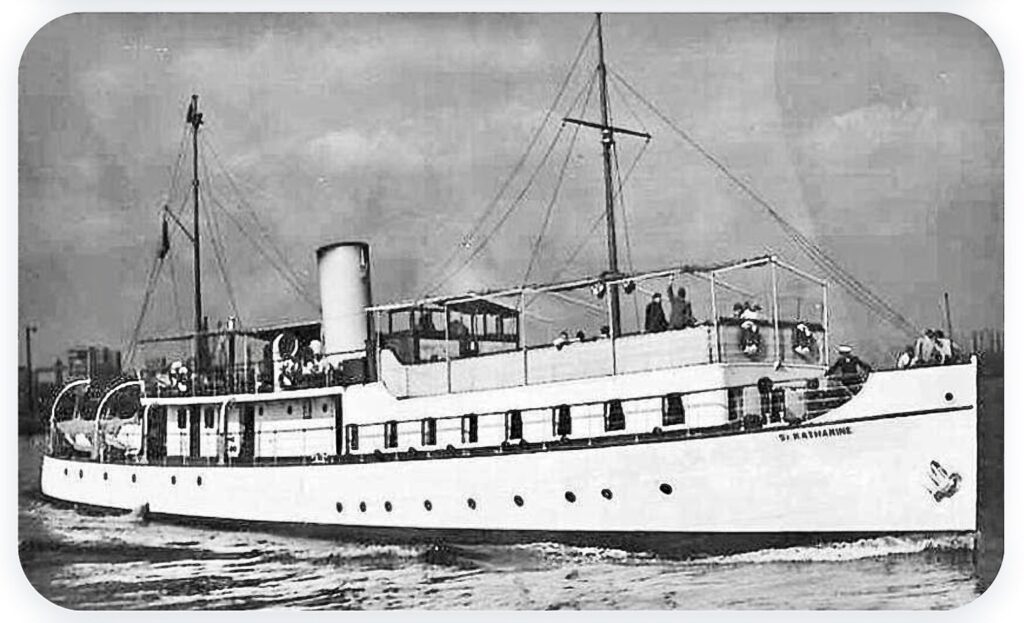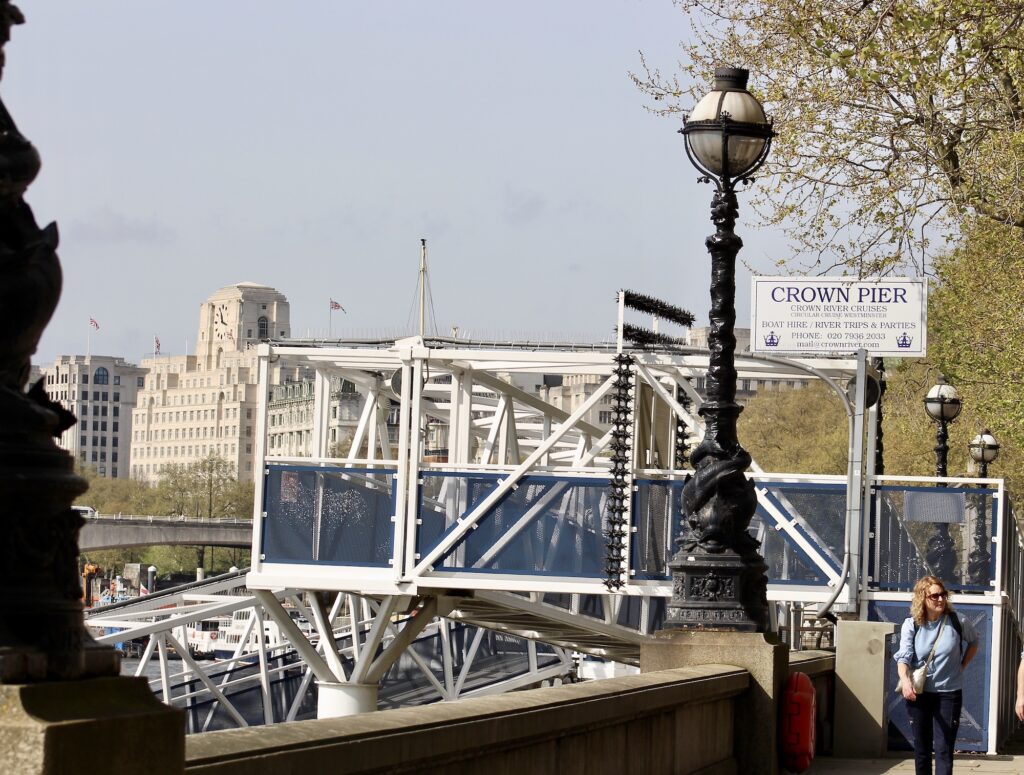A look along a section of the Victoria Embankment from Waterloo Bridge to Blackfriars Bridge.
Celebrated for his planning and work on the London sewers after the infamous “Great Stink” of 1858, Sir Joseph Bazalgette also designed, as part of the overall scheme, the embankment of the central London River Thames. The work took place in three stages: the Albert Embankment running between Vauxhall and Westminster Bridges, completed in 1868; the Chelsea Embankment finished 1874; and the Victoria Embankment which opened in 1879.

Set above Temple Stairs, this square-headed arch, part of Sir Joseph Bazalgette’s design for the Victoria Embankment, is an impressive feature on this stretch of the River Thames. The block within the arch was designed by Sir Edwin Cooper for the Port of London Authority and records the naming of this section of the river as the ‘King’s Reach’ in 1935 to celebrate the Silver Jubilee of King George V.
The inscription reads:
“In Commemoration of theTwenty-Fifth Anniversary of the Accession of His Majesty King George V, This Reach of the river between London Bridge and Westminster Bridge was, with His Majesty’s Gracious permission, named by The Port of London Authority ‘King’s Reach’.
Chairman: The Right Honourable Lord Ritchie of Dundee May 1935.”
Whereas some moorings and boats stay more or less in the same position others fluctuate and, apart from one image, my photographs capture elements of this section of the King’s Reach from 2022 to 2024. Beginning with the Tower RNLI Station by Waterloo Bridge and followed by CPBS Marine Services and Capital Pleasure boats; the yacht St. Katherine; SB Wilfred; HQS Wellington, I end with the Tideway ‘super sewer’ site by Blackfriars Bridge.



The famous central London Thames-side lamps, the ‘dolphin’ lamps, were designed by George Vulliamy, chief architect to the Metropolitan Board of Works from 1861-86.


Lifeboats Hurley Burley and Hearn Medicine Chest, based at the new Tower RNLI Station by Waterloo Bridge, cover the central London Thames. Nearly 400 lives have been saved by Tower crews since their establishment on the river in 2002. There has been a pier here since the nineteenth century. See its history here.


The Capital Pleasure Boats are an impressive sight at their Temple Pier mooring on the Victoria Embankment. If you have spent any time by the Thames in central London you might well have seen their party boats: Golden Flame, Golden Jubilee, Golden Star and Golden Sunrise on their cruises. The Company was formed by four partners in 2002 with their first boat the Golden Jubilee, and is an important player on the Thames party scene.

Based at Temple Pier too, are CPBS Marine Services‘ wide range of craft operating on the river. Their multicats, tugs and workboats are a familiar sight on the central London Thames but they also operate flattops, crane barges, hoppers and lighters. You might have seen them out and about on the river attending to all kinds of marine tasks, including “towage, dive support, and film work.” I have come across multicats Hound Dog, Sea Dog, Shake Dog, Bulldog and Chili Dog, attending to various operations, and frequently see workboats Watchdog and Guard Dog going about their business along Lambeth Reach, which is where I spend some time most days.
CPBS Marine Services also undertake “subsea cable installation and shore connection, buoy maintenance and dredging support.”

Historic Ship SB Wilfred, a popular bar, restaurant and nightclub, sank at her Temple Pier mooring on January 4th, 2024 during Storm Henk. She was refloated, as you can see in the photograph below but she was so severely damaged that she was scrapped a few weeks later at EMR, Anchor Bay, Erith.

An ATYC news bulletin describes how “The CPBS multicats Hound Dog, Bulldog and Sea Dog were used to drag SB Wilfred away from the pier. She was pumped out forward and floatation bags used to give additional buoyancy.” On Friday February 2nd, Shake Dog towed her on her last journey, downstream to Erith.


Closed at present, after serving as a floating restaurant since 1971, work appeared to be underway as I passed the St. Katharine earlier in the year. Her wheelhouse has been removed and a new metal superstructure has been built on the deck.
Now moored at Temple Pier she began life in 1927, built of steel and aluminium by Phillip & Son Ltd. in Dartmouth. She was registered at London and bought by the Port of London Authority. She is, according to ‘The Liquid Highway’ , as you can see in the picture below, “possibly one of the nicest vessels that the PLA have ever owned”.

In 1939 she was taken over by the Admiralty. Manned by a Royal Navy Reserve Crew, she was equipped with a three pounder and twin lewis guns. Guarding the Medway Channel in the Thames Estuary, she saw action in November 1939 as enemy aircraft tried to drop parachute mines into the river. They were repelled by the force of St. Katharine’s fire power, making her the first vessel to engage the enemy in the Port of London.

In 1946 the St. Katharine was released back to the Port of London Authority and after an extensive refit, she became a cruise ship for visiting VIPs. She also undertook regular tours around London’s Docklands. She was decommissioned by the Port of London Authority in 1971 and became a floating restaurant.

An eye-catching sight on the King’s Reach, the former HMS Wellington is a ship with an interesting history. Built in the Devonport Dockyard, Plymouth, and launched in May 1934, she was posted to the Royal Navy Far East Fleet, patrolling New Zealand waters and the Western Pacific. She was recalled to Britain in 1939 as a war in Europe became inevitable.
An article on the National Historic Ships website explains how “She served in the Atlantic throughout WWII, one of only 12 warships continuously engaged in the Battle of the Atlantic and earning her the Battle Honour “Atlantic 1939-1945”. Equipped with the most advanced weapons of the day, as part of the Royal Navy, she escorted and protected, along with other ships, over ninety-five Atlantic convoys, the vital lifeline to keep Britain supplied with food, fuel and military resources during the Second World War. She rescued over four hundred survivors from the sea and was involved in the destruction of a German U-Boat. “She is Britain’s only surviving warship from the Battle of the Atlantic.”

Converted from HMS Wellington to HQS Wellington, she arrived at her Temple Stairs’ mooring on Victoria Embankment in December 1948, where she served as the floating Livery Hall, for the Honourable Company of Master Mariners. In 2005 the ownership of HQS Wellington was taken on by The Wellington Trust, a registered charity responsible for her preservation and the promotion of Britain’s maritime heritage through a variety of educational programmes, hosting regular exhibitions and events. She can also be hired for special occasions and conferences. See here.
The Honourable Company of Master Mariners, left HQS Wellington in April 2023, moving to a temporary office in Greenwich.
Film of the arrival of HQS Wellington at Temple Stairs in 1948.


Set on Victoria Embankment with fine views, this is one of the eight surviving cast iron City Police public call boxes, now no longer in use. Once there for people to use in case of emergency, they were also a means for police stations to contact constables on patrol in the area by flashing the light on the top. The first of the three doors housed a telephone, the middle opened out to provide a writing surface, and the bottom a first aid kit. The author of London on the Ground adds that “Some PCs in the Smithfield market area used these cupboards to store cuts of meat until it was time to go home at the end of their shift.”




Before drilling for the tunnel started on the Blackfriars Tideway site, the area had to be protected from the river by a cofferdam. The tunnel is now 48 metres below the site. Once in operation, the impressive 25-kilometre long Tideway ‘super sewer’ for London will intercept and transfer sewage away from the River Thames. Recent heavy rainfall has exacerbated the sewage pollution problem in the river so Tideway’s awe-inspiring project cannot come online too soon. However, Thames Water should play their part too by improving performance and actively lobbying against the flushing of non biodegradable sanitary products and wet wipes into the system.



Heroes commemorated on the Victoria Embankment wall
There are two memorials, not counting the arch dedicated to the Silver Jubilee of George V: one to the submariners who lost their lives in both World Wars and one to journalist W.T. Stead, who lost his life on the RMS Titanic, but although Sir Joseph Bazalgette’s memorial is just upstream from the area I have covered here, his long-lasting achievements deserve celebration.

The debt London’s owes to Sir Joseph Bazalgette is immense and his legacy is widely acknowledged by Tideway, the company nearing the completion of London’s new ‘super sewer’. His name is mentioned no less than forty-nine times in their document Heritage Interpretation Strategy. And indeed his name will be further commemorated by Tideway in the new Bazalgette Embankment by Blackfriars Bridge, providing a 1.5 acre open space for Londoners and visitors alike to enjoy views of the river.

The National Submariners’ War Memorial, attached to the Victoria Embankment Wall, was unveiled in 1922. The central panel depicts four submariners contending with the dangers of the ocean, represented by figures on either side attempting to snare the crewmen in their nets. The left hand panel lists the submarines lost in 1914-1918 and the right hand panel added later, lists the submarines lost from 1939 to 1945.

William Thomas Stead was a journalist, firstly editor of the Northern Echo, later editor of the Pall Mall Gazette and the monthly journal Review of Reviews. His press campaigns brought about many changes, including the enhancement of British naval defences. In 1886 he published a short story in the Pall Mall Gazette: “How the Mail Steamer Went Down in the Mid Atlantic, by a Survivor”, which told of a tragedy at sea when two ships collided, and he made the point that there could have been fewer casualties had the ships carried more lifeboats. Stead added that, “This is exactly what might take place and will take place if liners are sent to sea short of boats.” And it was exactly what did take place when the RMS Titanic hit an iceberg and he was one of the more than 1,500 passengers on the ship who lost their lives.

Sources and further information
I have added links to passages in the text but here follow my main sources:
Meet the Capital Pleasure Boats fleet by clicking here.
Discover the CPBS Marine Services fleet here.
For more information on the old City Police boxes see London on the Ground
Imperial WarMuseum MemorialNational Historic Ships UK for the wartime history of the former HMS Wellington.
National Historic Ships St. Katharine
National Historic Ships Sailing Barge Wilfred
Tideway ‘super sewer’ for London
With thanks to Ben at Liquid Highway.
See: https://thameshighway.wordpress.com